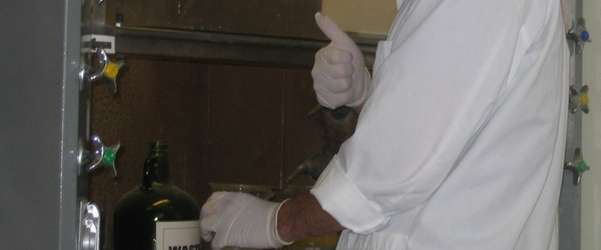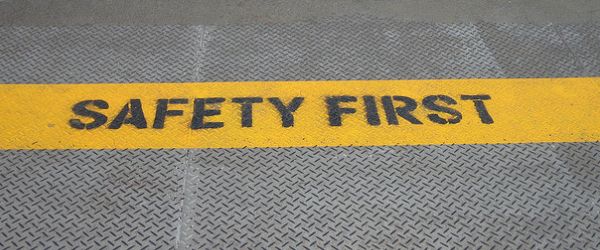Nobody wants to be embarrassed.
Nobody wants to be disfigured.
Nobody wants to die early.
Working with and among chemicals is often dangerous and can lead to these scenarios. But there are a lot of chemicals. Therefore, there are a lot of hazards.
As a chemist who defected to biosciences, I’ve observed a difference in attitude towards health and safety between the two disciplines. And I’ve got to say, biosciences, up your game.
The biology lab I completed my Ph.D. in didn’t even have a fume hood. We just held our breath.
Allow me, then, to give you a chemist’s guide to working safely in the lab.
Let’s go through ten broadly applicable golden rules to help keep you and your colleagues working safely in the lab.
1. Work in a Fume Hood Unless You Have a Reason Not To
It’s safer to assume that most chemicals can harm you than they cannot.
You and I are also aware of the function, reactivity, and danger of only a tiny fraction of chemicals in our respective laboratories. This is forgivable—the chemical inventory for my lab runs to well over 1000.
If you have easy access to a fume hood, why choose not to work in it?
Okay, so I’m not saying work in a fume hood for tasks such as DNA transformation or cell culture inoculation (this is a key point that we’ll return to—you and me knowing approximately what chemical processes are taking place).
But diluting acids and bases for use with the pH meter, preparing SDS-PAGE gels, and spiking samples with reducing agents all involve hazardous chemicals, fumes of which we’d be better off not breathing in.
And remember, our exposure is chronic. We work in the lab.
You should not take out an organic solvent you have never worked with, ignore the COSHH form, and start using it on the bench. This leads me to a corollary.
Respect Your Colleagues
If somebody was using an odorless mutagen on the bench, I am sure you would prefer not to enter the lab.
The great thing is, you can take the onus of responsibility yourself and never do something so daft. Then, if everyone else did the same, we’d all be safe from such stupidity.
Remember, there’s a tacit agreement when we work in the lab that we are responsible for each other’s well-being and our own.
2. Apply Logical Chemical Segregation
To ensure your lab is safe for everyone to work in, separate:
- Acids.
- Bases.
- Oxidizers.
- Flammables.
- Poisons.
Why is that?
In short, acids, bases, and oxidizers react violently with each other and organic material.
Introducing heat to flammable and poisonous chemicals is bad news all around.
And poisons include anything with the skull and crossbones symbol, all carcinogens, teratogens, and mutagens. Examples include reducing agents, heavy metal salts, and histological stains such as trypan blue.
It’s also prudent to have dedicated storage at:
- -80°C.
- -20°C.
- 4°C.
- 20°C.
The ideal storage temperature for any chemical is printed on the bottle. Please read it.
3. Pay Attention to Hazard Symbols
Bitesize Bio has an excellent article on hazard symbols that tells you what they all mean. I shan’t repeat it.
However, hazard symbols are designed to be simple, obvious, and transcend language.
And, to state the obvious, they are designed to keep everyone and the environment safe! That’s why the UK government agency responsible for workplace health, the Health and Safety Executive, lists the hazard symbols too.
The equivalent American agency is the Occupational Safety and Health Administration.
If you want to refresh yourself on hazard symbols and provide a gentle reminder to your labmates, download our lab safety poster.
4. Pay Attention to Function
Maybe you chose a career in biology simply because you have a distaste for chemistry. I have a distaste for chemistry yet have a degree in it. That’s why I do biology now.
Grievances aside, knowing something about how compounds function can help keep us safe by cultivating a healthy respect for the substances we work with. Let me give a few examples.
Glutaraldehyde crosslinks lysine residues in proteins. It will not discriminate between those proteins in your nose and brain and those in your sample.
Beta-mercaptoethanol (BME) breaks disulfide bonds. It will not discriminate between those in (say) your antibodies and those in your sample.
Many DNA stains intercalate between DNA base pairs. You see where I am going with this.
Stop and think about what the chemical you are using does. Sometimes, we are stupidly busy, however. Hence rule 1 in this list.
5. Don’t Assume Equally Available Chemicals Are Equally Safe
There’s a bad habit of thought, tantamount to a fallacy, that exists in some scientists. It goes something like:
If this chemical were dangerous, I wouldn’t be allowed to use it/have to sign it out/ask permission/log my use, etc. But we have large quantities of this chemical to use freely. Therefore, it cannot be dangerous.
Put like this; it sounds daft.
But I have, for example, witnessed a student take a large bottle of dangerous, volatile carcinogen and use it on the bench— extremely dangerous complacency.
If every dangerous chemical were controlled, no work would get done. There comes a time, usually at the start of postgraduate studies, when it is assumed you are competent enough to work safely.
This is a daunting frontier. But it is an essential part of becoming an independent career scientist.
At some point, we must all move past the prescriptive attitude towards health and safety that we inherit during undergraduate studies.
Dedicated technical staff and your local health and safety officer are there to support and advise you, but you are assumed to be able to make safe decisions.
6. Always Add to Water
Diluting strong acids into water is exothermic.
Adding alkali metals to water generates enough heat to produce a flame.
Sodium azide is one chemical among many that react violently with water.
Water has a large capacity to absorb heat (heat capacity). In fact, it takes 4180 joules of energy to heat one kilogram of water by one-degree centigrade. [1]
When a small amount of water is added to strong acids such as concentrated HCl, alkali metals, or relevant chemicals, there are enough water molecules to trigger the violent reaction.
But there is no contingency to stop the reaction from running away violently.
When any of the above species are added to water, there are enough water molecules to trigger the violent reaction.
And there’s a massive excess of energy-absorbing water to take up all the excess heat until the reaction ceases. Thus explaining why you should always add to water.
7. Pay Attention to Tip and Spill Hazards
Here’s a simple rule.
Place the biggest containers at the bottom of any cupboard and the smallest at the top.
That way, if the Winchester of DMSO falls out of the cupboard, it is unlikely to smash and trigger an evacuation.
Pay attention also to what chemicals you have at eye-level on your bench!
Also, Luer syringe filters do pop off every now and then, squirting the liquid in the syringe everywhere in the process. So have a good think about what it is you are filtering.
8. Work Efficiently to Minimize Handling Steps
Let’s run through this one with an imaginary scenario. You need to add a small aliquot of a pungent and toxic reagent to your sample. Let’s say it is BME. You could:
- Take the lid off the BME.
- Adjust your pipette to the correct volume.
- Pick up the BME in one hand, pipette in the other.
- Aspirate the BME.
- Put the BME and pipette down.
- Take the lid off your sample.
- Dispense the BME.
- Close the lid on your sample and the BME.
Or you could:
- Adjust your pipette to the correct volume.
- Take the lid off your sample.
- Take the BME in one hand.
- Aspirate and dispense the BME with one hand in one movement.
- Simultaneously put the lid back on the BME.
- Secure both lids.
The second option exposes you to less BME (or whatever the reagent in question is) and is less of a faff.
I accept that such efficiency comes with experience. But I suspect I am not alone when I say my day-to-day Ph.D. experiments were hard to fit into a day.
Why not work efficiently and safely?
9. Learn (Some of) the Periodic Table
Okay, I’m not suggesting you learn every element and its position (although that is not a terrible idea in itself).
But learn some of the groups of elements that are present in reagents you use often. Then, try and understand the rudimentary chemistry of those groups.
For example:
Transition metals—form attractive but usually toxic solutions. They coordinate ligands. Therefore, they are used in metal affinity chromatography. We cannot dispose of them down the sink.
Noble gasses—are inert. Therefore, they are used in analytical chromatography and cryogenics.
Heavy metals—are usually available as toxic salts. They have lots of electrons and are good at absorbing radiation. Therefore, they are used as stains in electron microscopy and histology.
And so on.
Cultivating such an understanding of the elements and their applications enables you to infer potential hazards simply from the nature of the work you are carrying out.
10. Risk Assess Your Work
That’s to say, before you start any experimentation, sit and think about the chemicals you will use, the quantities you will use, and routes of exposure (e.g., inhalation, skin permeation, etc.).
Then, think about how you can mitigate any risks.
Are there safer alternatives to a dangerous reagent? Or maybe just a safer formulation?
Should you set an upper limit on the number of samples you process in a given session to reduce the number of dangerous chemicals to which you are exposed?
Can you augment your apparatus and PPE to work more safely? For example, wearing long-cuffed butyl gloves instead of nitrile ones. Or perhaps a face shield instead of safety glasses?
If you are lucky, you might work in a group that employs a technician whose job is to risk-assess its procedures.
In that case, please make an effort to read and sign the risk assessments. The technician won’t have written them for a laugh.
Working Safely in the Lab Summarized
And there are the ten golden rules for working safely in the lab. Hopefully, there’s some advice you can take from this article to augment either your individual work or laboratory-wide procedures.
I know I’ve left out some topics. Waste disposal procedures perhaps being the obvious one. There should be a set of local rules in place for this.
And as the adage goes, there’s an exception to every rule. So, if you think of any exceptions to anything I’ve said, then feel free to drop them in the comments below.
The same goes if you outright disagree with me on anything—we’re all learning from each other.
Want to make hazard symbols clear to everyone to keep your lab and buddies safe? Download our free lab safety poster and pin it up in your lab. Or download our lab safety eBook for more comprehensive guidance!
Reference
- Khachan J (2018) Heat capacity, specific heat, and heat of transformation. In: Thermal properties of matter, 1st edition. Morgan & Claypool Publishers: Online






